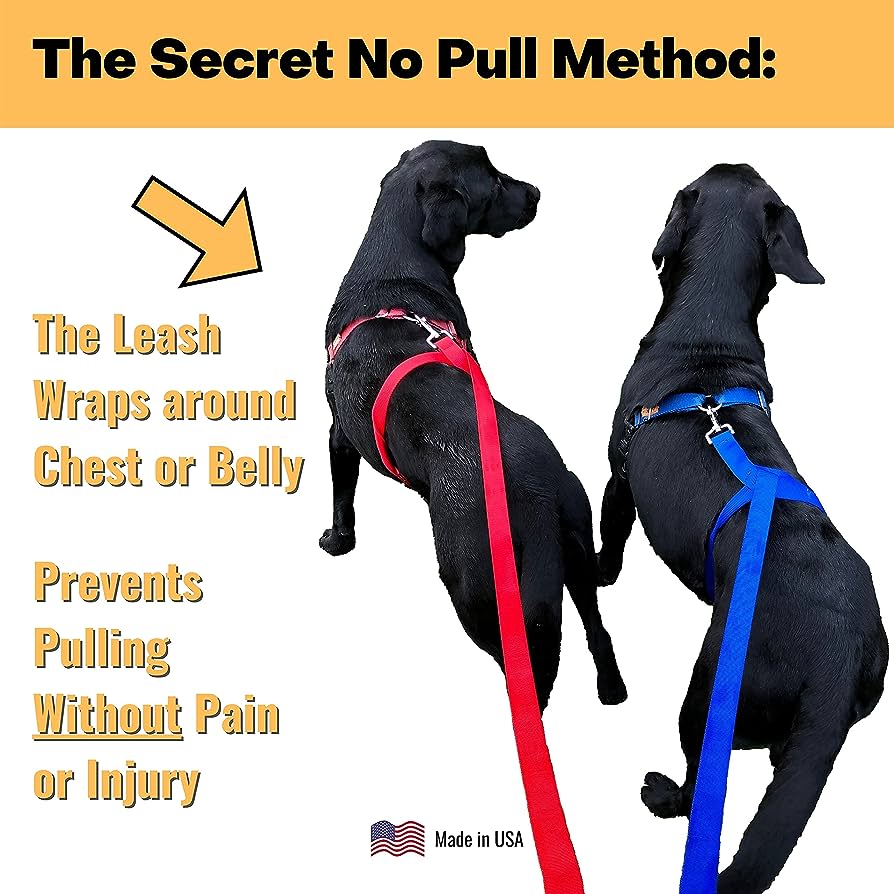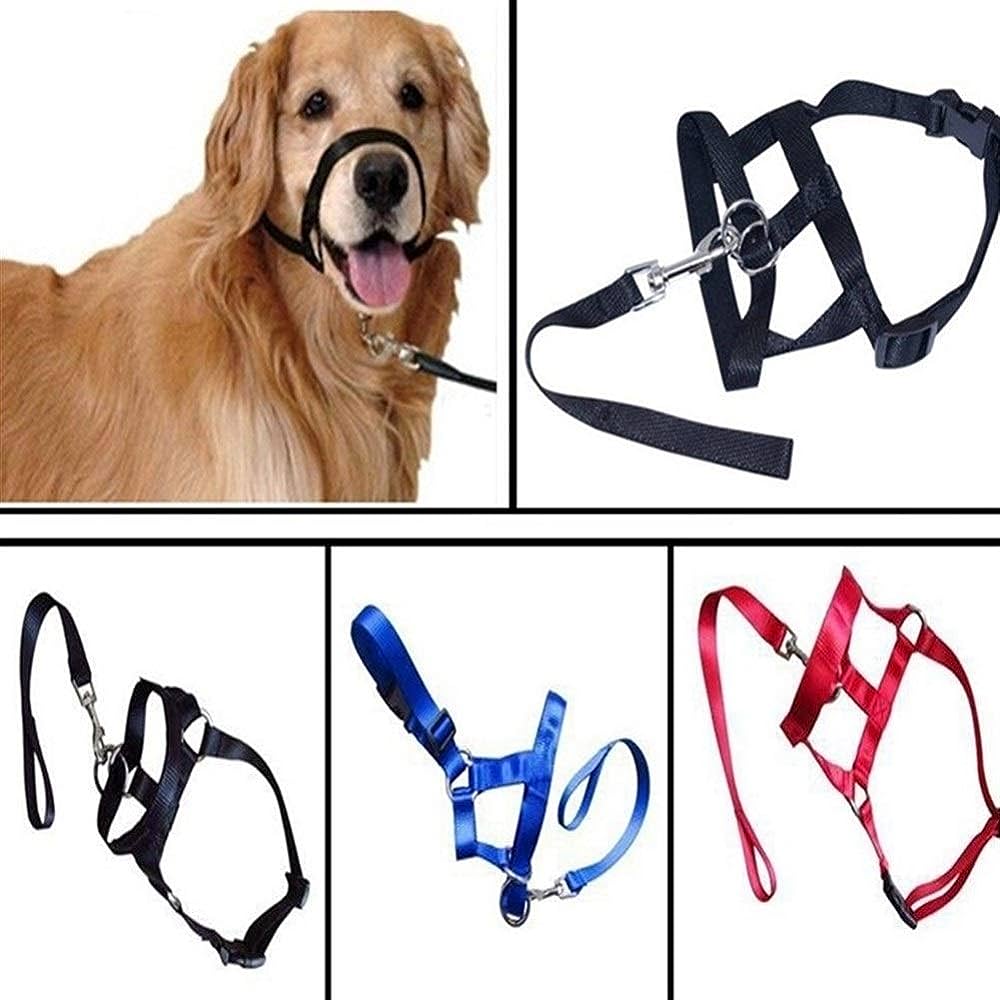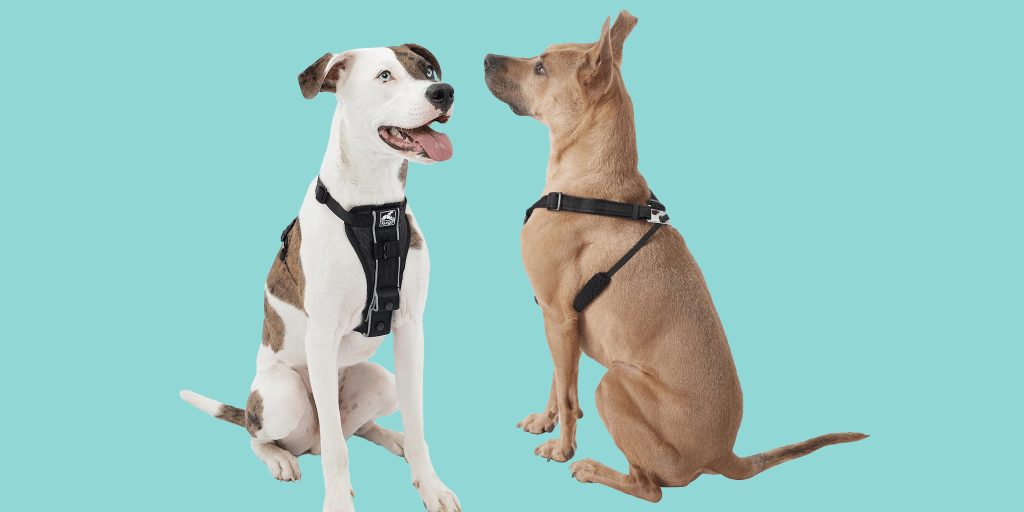Imagine walking with your furry friend, only to find yourself practically pulled off your feet as your dog relentlessly tugs on the leash.
We’ve all been there. Well, fret not because there is hope! In this article, we will explore many dog owners’ questions: Is there a device to stop a dog from pulling on a leash?
Whether you have a small pup or a giant, more powerful puppy, we will uncover some clever tools to make your walks a more pleasant experience for you and your four-legged companion.
So, let’s leash up and discover the key to stress-free strolls!
Why Do Dogs Pull on Leashes?
Natural Instincts
One of the main reasons why dogs pull on leashes is due to their instincts. Dogs have a strong prey drive, so they are prone to chase after anything that moves. When they sense movement while being on a leash, their instinct is to try to go after it, resulting in pulling.
Excitement and Curiosity
Dogs are naturally curious creatures, and when they are out on a walk, they may encounter various sights, sounds, and smells that pique their interest. This excitement and curiosity can lead to pulling on the leash as they explore their surroundings or greet other animals or people.
Lack of Training
Another reason why dogs pull on leashes is a lack of proper training. If a dog has not been taught how to walk on a leash correctly, they may resort to pulling as a way to lead the walk or get to where they want to go. Without a clear understanding of leash manners, dogs may not realize the importance of walking calmly beside their owner.
Lack of Exercise
Dogs are energetic animals that require regular exercise to maintain their physical and mental well-being. When dogs do not receive enough physical activity, they can become restless and eager to release their pent-up energy. This lack of exercise may manifest as pulling on the leash as they attempt to expel their excess energy.
Fear or Anxiety
Fear or anxiety can also cause dogs to pull on leashes. Fearful or anxious dogs may try to escape from what they perceive as a threatening situation, which can result in pulling. Identifying the underlying cause of fear or anxiety and addressing it appropriately is essential to prevent leash-pulling behavior.
Consequences of Dog Pulling on Leash
Physical Discomfort for Dog and Owner
A dog pulling on a leash can create physical discomfort for the dog and the owner. The constant tension on the leash can cause strain on the dog’s neck, leading to discomfort or potential injuries. Additionally, the owner may experience pain or discomfort in their hands or arms from trying to control the pulling dog.
Potential Injuries
The act of pulling on a leash can potentially cause injuries to both the dog and the owner. Dogs that pull forcefully may strain their neck, leading to muscle strains or even injuries to the windpipe. On the other hand, owners may suffer from injuries such as sprained wrists or falls if they are unable to maintain their balance while their dog is pulling.
Difficulty Controlling the Dog
When a dog consistently pulls on the leash, it becomes challenging for the owner to control the dog’s movements. This lack of control can be dangerous in various situations, especially near traffic or crowded areas. It is crucial to address leash-pulling behavior to ensure the safety of both the dog and the owner.
Strained Relationship with Dog
Continuous leash pulling can strain the relationship between a dog and its owner. The frustration caused by the constant pulling can lead to negative interactions and a breakdown in communication between both parties. This strained relationship can hinder the overall bond and trust-building process between the dog and its owner.
Traditional Training Methods
Positive Reinforcement
Positive reinforcement is a training method that involves rewarding desired behaviors to encourage repetition. Regarding leash pulling, positive reinforcement can be used to reward the dog for walking calmly beside the owner. Treats, verbal praise, or petting can serve as positive reinforcements to reinforce the desired behavior.
Negative Reinforcement
Negative reinforcement involves removing or avoiding an unpleasant stimulus to increase the likelihood of desired behavior. In the context of leash pulling, negative reinforcement can be employed by applying gentle pressure on the leash when the dog starts to pull. The pressure is released immediately when the dog stops pulling, reinforcing the idea that pulling leads to discomfort.
Familiarizing the Dog with the Leash
Familiarizing the dog with the leash is an essential part of training. This can be done by introducing the leash gradually, allowing the dog to sniff and investigate it. Positive associations can be established by offering treats and praise whenever the dog interacts positively with the leash. The goal is to make the leash a familiar and non-threatening object to the dog.
Devices to Stop Dogs from Pulling on Leashes
Head Halters
Head halters are devices that fit over a dog’s muzzle and head, similar to a horse’s bridle. They work by controlling the dog’s head movements, making it difficult for them to pull on the leash. Head halters distribute pressure evenly, reducing the likelihood of discomfort or injury. However, it is essential to use head halters correctly and ensure proper fitting to avoid harm or distress to the dog.
No-Pull Harnesses
No-pull harnesses are designed to discourage leash pulling by redirecting the dog’s attention and redistributing the pulling force. These harnesses typically have a front attachment point on the chest, which helps to discourage pulling by gently redirecting the dog’s forward motion towards the owner. No-pull harnesses are generally considered a more comfortable alternative to traditional collars and are recommended for dogs that are prone to tracheal or neck injuries.
Prong Collars
Prong collars, also known as pinch collars, consist of metal links with prongs that pinch the dog’s neck when they pull on the leash. The purpose of these collars is to provide a corrective stimulus when the dog starts to pull, encouraging them to walk calmly beside the owner. However, prong collars should be used with caution and under the guidance of a professional trainer to ensure they are fitted correctly and used in a manner that avoids harm or discomfort to the dog.
Slip Collars
Slip collars, also known as choke chains, are a type of collar that tightens around the dog’s neck when they pull on the leash. The tightening action simulates a correction, discouraging pulling behavior. However, it is essential to use slip collars properly, as incorrect use can lead to injury or discomfort. Slip collars should only be used under the guidance of a professional trainer to ensure their safe and effective use.
Electric Collars
Electric or shock collars deliver an electric stimulus to the dog when it pulls on the leash. The purpose of electric collars is to provide a deterrent and discourage leash pulling through a corrective stimulus. However, the use of electric collars is a controversial topic, and their use should be approached with caution. Proper training and guidance from a professional are crucial to ensure the safe and ethical use of electric collars.
Head Halters
Function and Design
Head halters are designed to fit over a dog’s muzzle and head, controlling the dog’s head movements. They consist of straps that wrap around the dog’s neck and muzzle, with an attachment point on the back of the head or under the chin. The leash is attached to the head halter, allowing the owner to have better control and redirect the dog’s movements.
Effectiveness
Head halters can be highly effective in preventing dogs from pulling on leashes. By controlling the dog’s head, head halters make it difficult for dogs to pull forcefully. The pressure and redirection provided by head halters can help to discourage pulling behavior and promote more calm and controlled walking.
Training Process
Introducing a head halter to a dog requires a gradual training process. It is recommended to start by associating the head halter with positive experiences, such as treats or playtime. Once the dog is comfortable wearing the head halter, leash training can begin. This involves rewarding the dog for walking calmly beside the owner and redirecting any pulling behavior.
Pros and Cons
Some advantages of using head halters include increased control over the dog’s movements, reduced likelihood of neck or tracheal injuries, and positive reinforcement of calm walking behavior. However, it is essential to note that head halters may take time for dogs to adjust, and incorrect fitting or improper use can cause discomfort or distress. It is crucial to follow proper instructions and guidelines when using head halters.
No-Pull Harnesses
Function and Design
No-pull harnesses are designed to discourage dogs from pulling on leashes by redirecting their attention and redistributing the pulling force. They typically have a front attachment point on the chest, which helps to steer the dog’s movements toward the owner. Some harnesses also feature back attachment points for standard leash walking. No-pull harnesses are available in various styles and materials to suit dog sizes and breeds.
Effectiveness
No-pull harnesses can be highly effective in curbing leash-pulling behavior. The front attachment point on the chest allows owners better control over the dog’s direction and encourages them to walk beside the owner rather than pulling ahead. By redirecting the pulling force, no-pull harnesses help to promote more relaxed and controlled walking.
Training Process
Training a dog to walk on a no-pull harness usually involves positive reinforcement. Initially, the dog should be allowed to familiarize themselves with the harness and associate it with positive experiences such as treats or play. The leash training process involves rewarding the dog for walking without pulling and gently redirecting their attention if they starts pulling.
Pros and Cons
No-pull harnesses offer several advantages, including increased control over the dog’s movement, reduced risk of injury compared to traditional collars, and a more comfortable walking experience. However, some dogs may require time to adjust to wearing a harness, and proper fitting is crucial to ensure optimal effectiveness. Choosing a high-quality harness and following the manufacturer’s instructions for proper use is essential.
Prong Collars
Function and Design
Prong collars, or pinch collars, consist of a series of interlocking metal links with prongs that face inward. When the dog pulls on the leash, the prongs pinch on its neck as a corrective stimulus. Prong collars are designed to replicate the correction a dog would receive from another dog during pack behavior.
Effectiveness
Prong collars can be effective in discouraging dogs from pulling on leashes. The pinching sensation provides a deterrent and encourages the dog to walk beside the owner rather than pulling. However, it is crucial to use prong collars correctly and under the guidance of a professional trainer to ensure the dog’s comfort and safety.
Training Process
Training with a prong collar should only be conducted under the supervision of a professional trainer experienced in its use. The trainer will guide the owner on adequately fitting the prong collar and teach them how to provide corrections effectively. Positive reinforcement techniques are often used alongside prong collars to reinforce desired behaviors.
Pros and Cons
Prong collars offer certain advantages, including their ability to generate a strong correction that can deter pulling behavior. When used correctly, prong collars can be an effective tool for leash control. However, it is vital to approach their use with caution, as incorrect fitting or excessive force can cause discomfort, injury, or a negative association with the collar. The guidance of a professional trainer is essential when using prong collars.
Slip Collars
Function and Design
Slip collars or choke chains, consist of a loop that tightens around the dog’s neck when applying pressure. When the dog pulls on the leash, the slip collar tightens, simulating a correction that discourages pulling behavior. Slip collars are designed to be self-correcting, releasing tension as soon as the dog stops pulling.
Effectiveness
Slip collars can be effective in discouraging dogs from pulling on leashes. The self-correcting nature of the collar provides feedback to the dog, teaching them that pulling leads to discomfort. However, it is essential to use slip collars correctly and under the guidance of a professional trainer to avoid causing harm or distress.
Training Process
Proper training with a slip collar should be conducted under professional guidance to ensure the dog’s safety and comfort. The trainer will teach the owner how to fit the slip collar correctly and provide corrections in a controlled manner. Positive reinforcement techniques are often used alongside slip collars to encourage and reward desired behaviors.
Pros and Cons
Slip collars offer certain advantages, including providing immediate feedback to dogs when they pull on the leash. The self-correcting mechanism of the collar can help deter pulling behavior when used correctly. However, using slip collars with caution and proper guidance is crucial, as incorrect use can lead to injuries or discomfort. Regular monitoring and adjustment of the collar’s fit are necessary to ensure the dog’s safety.
Electric Collars
Function and Design
Electric collars, also known as shock collars, are electronic devices that deliver a mild electric stimulation to the dog when they pull on the leash. The stimulation level can be adjusted based on the dog’s response and sensitivity. Electric collars are designed to provide a deterrent that discourages leash pulling.
Effectiveness
Electric collars can be effective in deterring dogs from pulling on leashes. The correction delivered by the collar serves as a distraction and teaches the dog to associate pulling with an unpleasant sensation. However, using electric collars is controversial, and their effectiveness may vary depending on the individual dog and the training methods employed.
Training Process
Training with electric collars should only be conducted by experienced professionals who specialize in their use. The trainer will educate the owner on the correct fitting and use of the collar and the appropriate level of stimulation for the dog. Positive reinforcement techniques are often incorporated into the training process to reinforce desired behaviors.
Pros and Cons
Electric collars offer potential advantages, such as providing a consistent and immediate correction for leash pulling. They can be helpful for dogs that have persistent leash-pulling issues. However, it is crucial to approach the use of electric collars with caution and follow ethical guidelines. Improper use or excessive stimulation can cause distress or harm to the dog. Seeking professional guidance is essential when considering the use of electric collars.
Alternative Methods to Stop Dog Pulling
Positive Reinforcement Training
Positive reinforcement training is highly effective and humane to address leash-pulling behavior. By rewarding the dog for walking calmly beside the owner, they learn to associate good behavior with positive experiences. Treats, verbal praise, or petting can be used as rewards to reinforce the desired behavior.
Clicker Training
Clicker training is a form of positive reinforcement training that uses a clicker to mark desired behaviors precisely. The clicker’s sound is paired with rewards, allowing the dog to learn quickly and associate the click with a positive experience. Clicker training can be used effectively to teach dogs to walk calmly on a leash without pulling.
Ensuring Sufficient Exercise
Providing dogs with sufficient exercise is crucial in preventing leash-pulling behavior. Dogs with regular physical activity and mental stimulation are less likely to exhibit excess energy and restlessness on walks. Adequate exercise can help to reduce leash-pulling tendencies and contribute to a more relaxed and controlled walking experience.
Seeking Professional Help
If leash pulling persists despite attempts at training and the use of different devices, seeking professional help from a certified dog trainer or behaviorist is recommended. These professionals have the expertise to assess the dog’s specific needs and provide tailored training methods to address leash-pulling behavior effectively.
They can also guide owners in choosing the most suitable dog training tools and techniques.
In conclusion, while leash pulling is a common issue faced by many dog owners, various methods and devices are available to address this behavior. Understanding the reasons behind leash pulling, such as instincts, excitement, lack of training or exercise, and fear or anxiety, is crucial in implementing effective solutions.
There are options to suit different dogs and their specific needs, from traditional training methods like positive and negative reinforcement to devices like head halters, no-pull harnesses, prong collars, slip collars, and electric collars.
Additionally, alternative methods such as positive reinforcement training, clicker training, ensuring sufficient exercise, and seeking professional help can also contribute to successful leash training.
Ultimately, with patience, consistency, and the right approach, it is possible to stop a dog from pulling on a leash and transform walks into enjoyable and stress-free experiences for both the dog and their owner.














































